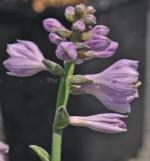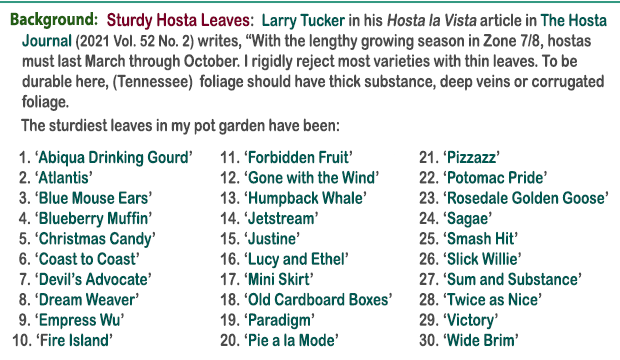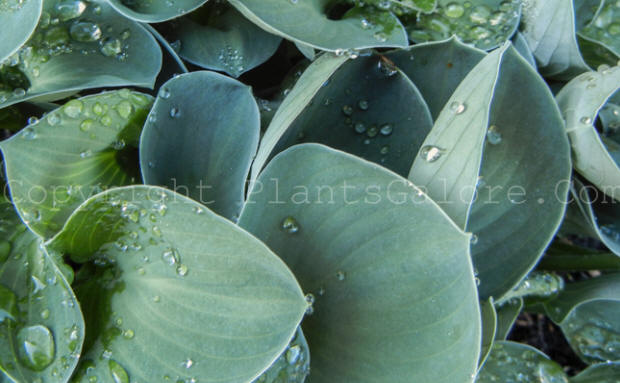  Originated by
Emile and Jane Deckert of Maryland, this cultivar
was the American Hosta Growers Association 2008 "Hosta of the Year" and
was winner of the
Benedict Garden Performance Medal for 2011. Originated by
Emile and Jane Deckert of Maryland, this cultivar
was the American Hosta Growers Association 2008 "Hosta of the Year" and
was winner of the
Benedict Garden Performance Medal for 2011.
A slow growing, small size (8 inches high by 19
inches wide) hosta, it
is a tissue culture sport of H. 'Blue Cadet' that was
registered in the year 2000. The leaves begin the year
blue-green and then change to dark green as the summer
progresses. They are slightly cupped and nearly round in shape. In July, it bears clusters of pale
purple flowers but is sterile so does not produce seeds.
 According to
The Hostapedia by Mark Zilis (2009), "The name of this cultivar wins my award for "Best Hosta Name",
conjuring up the idea of tiny, cupped, blue leaves." According to
The Hostapedia by Mark Zilis (2009), "The name of this cultivar wins my award for "Best Hosta Name",
conjuring up the idea of tiny, cupped, blue leaves."
From the
Field Guide to Hostas by Mark Zilis (2014), "...initiated the mini-hosta craze that continues to this
day."
The Book of Little Hostas by Kathy and Michael Shadrack
(2010) says: "The flower buds are attractively balloon-like. This
tough blue will look good in a container or trough."
The New Encyclopedia of Hostas by
Diana
Grenfell (2009) states: "An excellent specimen for a rock garden, gravel bed, or
a container...Has recently spawned a number of exciting
sports...Racemes are striking especially when in bud. Buds are
held horizontally and swell up like mini-balloons before
partially opening."

 In
his presentation at the 2019 Dixie Regional Hosta
Meeting in Delaware, Bob stated that Warren Pollock
had said that this is "the most unusual genetic hosta." When it "reverts", 'Blue Mouse Ears' does
not seem to go back to its 'Blue Cadet' heritage
which is very unusual. Mr PGC wonders if this might
be a case where rather than one or two traits
changing as in most sports, a large number of
recessive traits in 'Blue Cadet' suddenly expressed
themselves in this plant we call 'Blue Mouse Ears'
making it so unique...just a guess. In
his presentation at the 2019 Dixie Regional Hosta
Meeting in Delaware, Bob stated that Warren Pollock
had said that this is "the most unusual genetic hosta." When it "reverts", 'Blue Mouse Ears' does
not seem to go back to its 'Blue Cadet' heritage
which is very unusual. Mr PGC wonders if this might
be a case where rather than one or two traits
changing as in most sports, a large number of
recessive traits in 'Blue Cadet' suddenly expressed
themselves in this plant we call 'Blue Mouse Ears'
making it so unique...just a guess.
This hosta has been
the mother plant for many new hostas. Through 2017,
there have been around 24 named sports (see below)
of 'Blue Mouse Ears' introduced. Also another 28
cultivars have been sported from those hostas.


Warren I. Pollock
wrote comments about the many sports of H. 'Blue Mouse Ears' in
The
Hosta Journal (2012 Vol. 43 No. 2).
Click Here to view a summary of that article.
An article by Warren I. Pollock in
The
Hosta Journal (2014 Vol. 45 No. 1) states
that, "I'm in agreement with what
Bob Solberg...expressed at the 2013 Winter
Scientific Meeting in the Chicago area: "'Sum and Substance' is the second best
name ever for a hosta. Only H. 'Blue Mouse Ears' is better - but just slightly."
In answer to a question about growing smaller hostas that appeared in
The
Hosta Journal (2012 Vol. 43 No. 2),
W. George Schmid
of Georgia, author of
The Genus Hosta (1991) commented, "My favorite minis are
H. venusta,
H. gracillima, a white-margined sport of
H. gracillima named 'Kifukurin
Ko Mame', H. pulchella and 'Blue Mouse Ears' ."









|


 2003 -top.gif" width="618" height="24">
2003 -top.gif" width="618" height="24"> 2003 -bottom-heiden.gif" usemap="#FPMap1" width="618" height="50">
2003 -bottom-heiden.gif" usemap="#FPMap1" width="618" height="50">

 2003 -top.gif" width="618" height="24">
2003 -top.gif" width="618" height="24"> 2003 -bottom-heiden.gif" usemap="#FPMap1" width="618" height="50">
2003 -bottom-heiden.gif" usemap="#FPMap1" width="618" height="50">